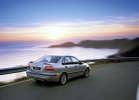Krash -test Volvo S40 1996 - 2000 sedan
Krash Test Volvo S40 1996, 1997, 1998, 1999, 2000: Laborator Assessment of Car Safety: Rating in points, report on the test (photo and video of the crash test)
26%
Driver and passengers
8%
Pedestrians
Protection of the driver and passenger
 Frontal blow, driver |
 Loba blow, passenger |
 Side blow, driver |
|
Children's holding devices
| Child up to 18 months | No information |
| A child over 3 years old | No information |
Safety of pedestrians
 |
|
Comments:
Four stars received four stars for protection at the frontal and lateral strikes of S40, becoming the first representative of the family class to achieve such a high result. With a frontal blow, the car showed itself well without appearing any weak places. However, the result could be improved by reducing the degree of deformation of the leg niche. The test instance was equipped with a head of the driver’s safety pillow and side airbags in the backs of the seats. This set was standard for the European market. The side pillows moved along with the seats, so they should have been effective in any position.Frontal blow:
The left windshield stand shifted back only 48 mm, and the passenger interior was deformed slightly. The driver's door managed to open, making some efforts, and the passenger opened easily. The steering wheel shifted back 59 mm and down 15 mm. The foot niche was subjected to moderate deformation, and the brake pedal shifted back 164 mm. The protection of the head and neck was good, and the contact with the airbag - stable. The protection of the chest was recognized as weak. The driver’s left knee hit the steering column casing and rested on the front panel, but the protection of knees, legs and pelvis remained at a high level. Despite this, there was a certain risk of damage to the lower part of the legs, and the crushing of the niche for the legs led to a decrease in the assessment for protecting the feet and ankles. The protection of the head, neck and both legs was recognized as good, although the load on the chest from the seat belt created some danger of damage.Safety of passenger children:
To install children's seats in Volvo, it was necessary to apply additional slings for a more reliable fastening. Some inconsistency was discovered between children's seats and the seats of the car, but this did not threaten the safety of young passengers. When installing a children's chair “against the direction of movement”, a floor support is put forward from its back. With a frontal blow, an armchair for an 18-month-old child showed a good result, but with a lateral passenger, his passenger was too close to the place of the car, where maximum damage was observed. Also, the mannequin sensors recorded a high risk of chest damage. For the chair established “in the direction of movement”, the pressed elements posed a much less danger. Although the test copy was not equipped with a passenger front pillow, the chairs can be used in a car with its presence.Side blow:
Assessment for protecting the driver’s head is “good”. Side airbags showed a good result, so protecting the chest, abdominal and pelvic parts was recognized as normal.Pedestrian safety:
Three of the six control points of the child’s head, comply with the requirements: above the air intake body, above the hood cover and above the pouring neck of the oil. One point showed the result above the average, and two below: above the fastening of the hinges of the hood cover and at its junction with the wing. None of the three points of impact of the upper part of the legs on the front edge of the hood met the requirements of Euro NCAP, showing the result worse than the average. Also, not one of the control points of the impact of the adult head met with the requirements, and only one of them showed the result better than average. The points of the legs of the legs also did not meet the safety requirements.General information about the car
| The location of the steering wheel | On right |
| Tested model | S40 (VS) |
| Type of body | 4-door sedan |
| Year of data publication | 1997 |
| Curb weight | 1231 |
Safety system equipment:
| Front seat belts | There is |
| Front seat belts load limiters | Not |
| Front Pillow of Safety of the driver | There is |
| Passenger front pillow | Not |
| Side airbags | There is |
| Side pillows of head safety pillows | Not |
| Knee -off pillow and legs of the driver | Not |












